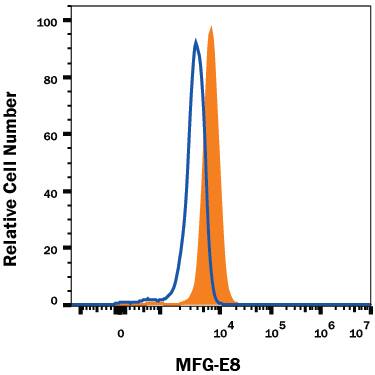Human MFG-E8 PE-conjugated Antibody
R&D Systems, part of Bio-Techne | Catalog # IC27671P


Conjugate
Catalog #
Key Product Details
Species Reactivity
Human
Applications
Intracellular Staining by Flow Cytometry
Label
Phycoerythrin (Excitation = 488 nm, Emission = 565-605 nm)
Antibody Source
Monoclonal Mouse IgG2A Clone # 278918
Product Specifications
Immunogen
Mouse myeloma cell line NS0-derived recombinant human MFG-E8
Leu24-Cys387
Accession # Q08431
Leu24-Cys387
Accession # Q08431
Specificity
Detects human MFG-E8 in direct ELISAs and Western blots.
Clonality
Monoclonal
Host
Mouse
Isotype
IgG2A
Scientific Data Images for Human MFG-E8 PE-conjugated Antibody
Detection of MFG‑E8 in Human Dendritic Cells by Flow Cytometry.
Human dendritic cells were stained with Mouse Anti-Human MFG-E8 PE-conjugated Monoclonal Antibody (Catalog # IC27671P, filled histogram) or isotype control antibody (Catalog # IC003P, open histogram). To facilitate intracellular staining, cells were fixed with Flow Cytometry Fixation Buffer (Catalog # FC004) and permeabilized with Flow Cytometry Permeabilization/Wash Buffer I (Catalog # FC005). View our protocol for Staining Intracellular Molecules.Applications for Human MFG-E8 PE-conjugated Antibody
Application
Recommended Usage
Intracellular Staining by Flow Cytometry
10 µL/106 cells
Sample: Human dendritic cells fixed with Flow Cytometry Fixation Buffer (Catalog # FC004) and permeabilized with Flow Cytometry Permeabilization/Wash Buffer I (Catalog # FC005)
Sample: Human dendritic cells fixed with Flow Cytometry Fixation Buffer (Catalog # FC004) and permeabilized with Flow Cytometry Permeabilization/Wash Buffer I (Catalog # FC005)
Formulation, Preparation, and Storage
Purification
Protein A or G purified from hybridoma culture supernatant
Formulation
Supplied in a saline solution containing BSA and Sodium Azide.
Shipping
The product is shipped with polar packs. Upon receipt, store it immediately at the temperature recommended below.
Stability & Storage
Protect from light. Do not freeze.
- 12 months from date of receipt, 2 to 8 °C as supplied.
Background: MFG-E8
References
- Raymond, A. et al. (2009) J. Cell. Biochem. 106:957.
- Couto, J.R. et al. (1996) DNA Cell Biol. 15:281.
- Yamaguchi, H. et al. (2010) Eur. J. Immunol. 40:1778.
- Haggqvist, B. et al. (1999) Proc. Natl. Acad. Sci. USA 96:8669.
- Silvestre, J.-S. et al. (2005) Nat. Med. 11:499.
- Borges, E. et al. (2000) J. Biol. Chem. 275:39867.
- Hanayama, R. et al. (2002) Nature 417:182.
- Ait-Oufella, H. et al. (2007) Circulation 115:2168.
- Kranich, J. et al. (2010) J. Exp. Med. 207:2271.
- Hanayama, R. et al. (2004) Science 304:1147.
- Kranich, J. et al. (2010) J. Exp. Med. 205:1293.
- Atabai, K. et al. (2009) J. Clin. Invest. 119:3713.
- Bu, H.-F. et al. (2007) J. Clin. Invest. 117:3673.
- Jinushi, M. et al. (2009) J. Exp. Med. 206:1317.
- Kvistgaard, A.S. et al. (2004) J. Dairy Sci. 87:4088.
Long Name
Milk Fat Globule EGF Factor 8
Alternate Names
BA46, Breast epithelial antigen BA46, Lactahedrin, Medin, MFGE8, SED1
Gene Symbol
MFGE8
UniProt
Additional MFG-E8 Products
Product Documents for Human MFG-E8 PE-conjugated Antibody
Product Specific Notices for Human MFG-E8 PE-conjugated Antibody
For research use only
